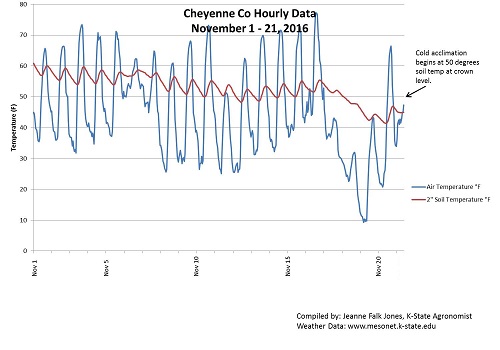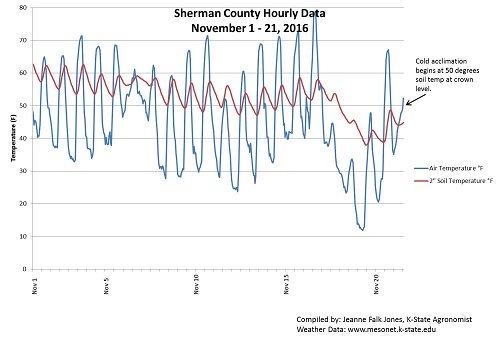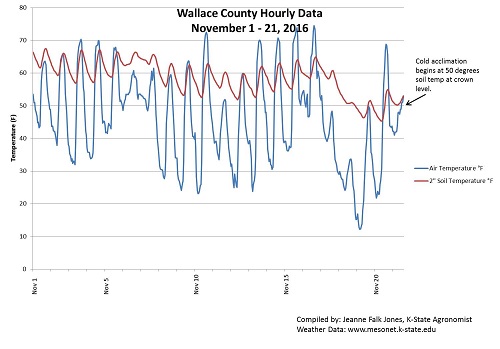November 2016
November 22, 2016 Update
I am sure many of you are wondering about how your wheat handled the quite chilly conditions last week. I would say the short answer is 'probably' the wheat is OK. That answer might sound a lot like 'it depends'! Several factors can influence the effects of the cold temperature. That includes how well the plant has cold hardened, the depth of the crown in the soil, the development of the root system, and the overall health of the wheat plant.
There are a couple factors that I think are most concerning for us. Those are how far along the wheat plant is in the cold hardening process and the root system development.
Let's first discuss the cold hardening process of the wheat plant. This is the factor that is most concerning for me. The wheat plant begins it's cold acclimation process when the soil temperatures at the crown fall below 50 degrees. At that temperature, an anti-freeze like compound is generated in the plant near the cell membranes to prevent them from rupturing from freezing.
In general, the air temperature moved down pretty rapidly over a two day period. In Sherman County, the air temperature fell 66 degrees in about 39 hours. The soil temperatures at 2" fell slowly during that period and fell from 58 degrees to 38 degrees. However, when looking at the charts for Cheyenne, Sherman and Wallace Counties (down below), you will notice the soil temperature rebounded from the coldest temperature pretty quickly and is roughly maintaining between 40 and 50 degrees. Prior to the cool down, the soil temperatures had not started cooling off a great deal for the fall. At some locations, the soil temperatures had made it to 50 degrees at night, but had not maintained at that level. So potentially, there wasn't a great deal of cold acclimation happening in the wheat plant prior to our cool down. But I am pretty sure the wheat plants are generating the anti-freeze compound now!
On the development of the wheat plant, Jim Shroyer, the retired wheat specialist, said that wheat has the best chance at winter survival when it has at least 2-3 true leaves, a tiller or two and a developed root system. This wheat development will have helped the plant to build up enough stored energy reserves to survive the winter. The seedlings will have a better chance of winter survival if their crowns are well developed in firm soil, about a half-inch below the soil surface. I mention this because I was a bit surprised when looking at wheat this last week. Some of it looked quite good from the top looking down. However, when I dug below ground to look at the roots, in some cases, there were not many roots developed from the crown of the plant. I am sure the dry conditions have impeded the root development, but I was a bit surprised to notice this lack of roots. This is definitely not true in all fields or in all of the plants that I looked at in a field. I thought it was worth mentioning though.
Finally, one factor that we always discuss with cold temperatures is the depth of the wheat crown. It is likely set between ½ -1 inch deep. The deeper the crown, the more protection the soil can provide from cold temperatures. Also, how moist the soil is can affect the protection of the crown. Drier soil changes temperature more quickly than wetter soil. In addition, any snow that was on the ground helped protect the wheat crowns from the cold temperatures on Saturday morning.
So all in all, be patient to know how our wheat responded to the colder temperatures last week. We will not know for a while how the wheat has really responded. I have collected some wheat and put in the greenhouse on the Experiment Station and it looks to be in good shape while warming up. I will continue to water it to see if it initiates new leaf growth and let you know what I find.
(Click on each graph for a larger version)


